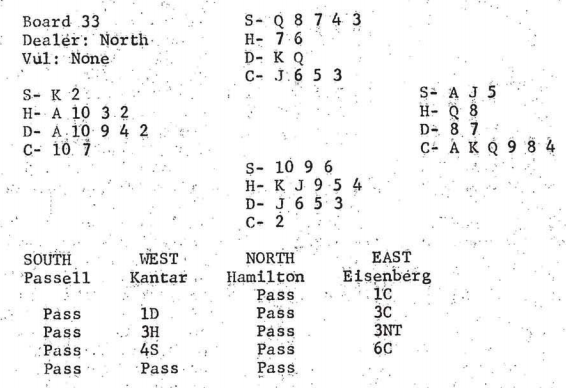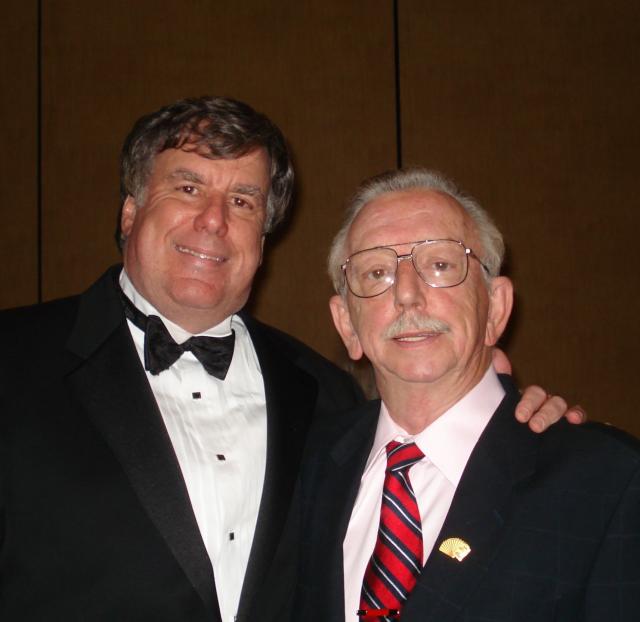1977 BERMUDA BOWL WORLD BRIDGE CHAMPIONSHIP
MANILA, OCTOBER 20-28, 1977, EDITOR: Henry Francis
The first 16 deals of, Thursday evening’s session, included slam after slam, and interest in the vu-graph was at fever pitch. Things got interesting on the very first deal, when Eisenberg got into a slam that had only remote chances.

How would you like to be in 6![]() ? First of all you, must get a heart lead. Then what do you do about the bad trump split? Billy got over the first hurdle when the opening lead was the
? First of all you, must get a heart lead. Then what do you do about the bad trump split? Billy got over the first hurdle when the opening lead was the ![]() 5. He held his breath as he let this ride to his
5. He held his breath as he let this ride to his ![]() 8. Next he cashed the
8. Next he cashed the ![]() K-A, and ruffed a spade. Two rounds of trumps disclosed the bad break, but he calmly went about neutralising Hamilton’s holding. He overtook the
K-A, and ruffed a spade. Two rounds of trumps disclosed the bad break, but he calmly went about neutralising Hamilton’s holding. He overtook the ![]() Q with the
Q with the ![]() A and ruffed a heart, then went to dummy with the
A and ruffed a heart, then went to dummy with the ![]() A and ruffed another heart. He was now down to a losing diamond and the
A and ruffed another heart. He was now down to a losing diamond and the ![]() Q 9. He merely exited with the diamond, and set back to win the last two tricks no matter who took the diamond. That was a 10 IMP pickup.
Q 9. He merely exited with the diamond, and set back to win the last two tricks no matter who took the diamond. That was a 10 IMP pickup.
Early analysis by the vu-graph commentators indicated that Passell played the grand slam on Board 41 along anti-percentage lines. Later analysis, proved that Ron had taken the best line possible, even though it failed.


In the involved bidding system used by Hamilton and Passell, the 6![]() response to 5NT showed a queen. Obviously Hamilton meant the
response to 5NT showed a queen. Obviously Hamilton meant the ![]() Q, but there was a misunderstanding, and Passell thought Hamilton had the
Q, but there was a misunderstanding, and Passell thought Hamilton had the ![]() Q instead. Of course, if the
Q instead. Of course, if the ![]() Q had been in dummy, the Grand slam would have been laydown. Passell won the opening heart lead with the ace, then took the
Q had been in dummy, the Grand slam would have been laydown. Passell won the opening heart lead with the ace, then took the ![]() K and
K and ![]() J, but the suit didn’t break. Next led to the
J, but the suit didn’t break. Next led to the ![]() K, and as he was thinking, the commentators were pointing out that he could get a complete count on the hand by cashing his winners.
K, and as he was thinking, the commentators were pointing out that he could get a complete count on the hand by cashing his winners.
Since he would discover in time that West had two clubs and East had four, he would have had to play for the queen-doubleton with West because there would be no way to pick four to the queen with East. While this talk was going on, Passell led a club and finessed the jack, losing’to the ![]() Q followed by the
Q followed by the ![]() 10 for down 2. At the other table, 6NT made 7, for a 15 IMP gain for the challenger’s.
10 for down 2. At the other table, 6NT made 7, for a 15 IMP gain for the challenger’s.
But let’s examine Passell’s play. If the queen protected were on his right, then he would have a squeeze position against one of his two opponents once the club finesse worked. If the long spades were with East, East could not hold on to all his clubs and still protect spades. And if West had the spades, he would be forced to save the ![]() 10 to cover the
10 to cover the ![]() 9 in dummy, so would have to unguard spades. So Passell’s line had more going for it than the one suggested on vu-graph, but it didn’t work.
9 in dummy, so would have to unguard spades. So Passell’s line had more going for it than the one suggested on vu-graph, but it didn’t work.
Esta entrada también está disponible en: Spanish

